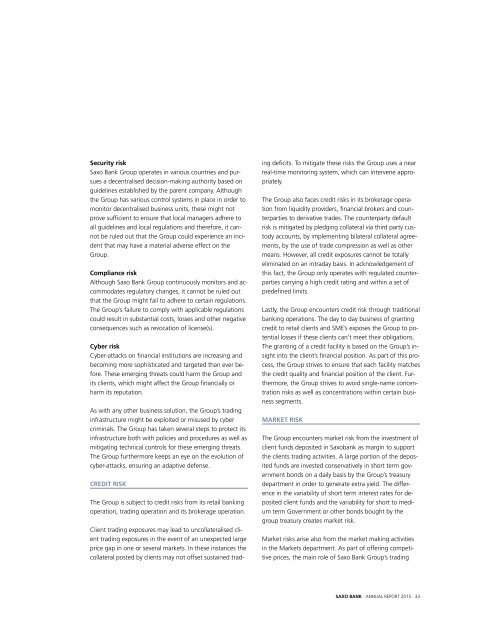saxo-bank-annual-report-2015
saxo-bank-annual-report-2015
saxo-bank-annual-report-2015
You also want an ePaper? Increase the reach of your titles
YUMPU automatically turns print PDFs into web optimized ePapers that Google loves.
Security risk<br />
Saxo Bank Group operates in various countries and pursues<br />
a decentralised decision-making authority based on<br />
guidelines established by the parent company. Although<br />
the Group has various control systems in place in order to<br />
monitor decentralised business units, these might not<br />
prove sufficient to ensure that local managers adhere to<br />
all guidelines and local regulations and therefore, it cannot<br />
be ruled out that the Group could experience an incident<br />
that may have a material adverse effect on the<br />
Group.<br />
Compliance risk<br />
Although Saxo Bank Group continuously monitors and accommodates<br />
regulatory changes, it cannot be ruled out<br />
that the Group might fail to adhere to certain regulations.<br />
The Group’s failure to comply with applicable regulations<br />
could result in substantial costs, losses and other negative<br />
consequences such as revocation of license(s).<br />
Cyber risk<br />
Cyber-attacks on financial institutions are increasing and<br />
becoming more sophisticated and targeted than ever before.<br />
These emerging threats could harm the Group and<br />
its clients, which might affect the Group financially or<br />
harm its reputation.<br />
As with any other business solution, the Group’s trading<br />
infrastructure might be exploited or misused by cyber<br />
criminals. The Group has taken several steps to protect its<br />
infrastructure both with policies and procedures as well as<br />
mitigating technical controls for these emerging threats.<br />
The Group furthermore keeps an eye on the evolution of<br />
cyber-attacks, ensuring an adaptive defense.<br />
CREDIT RISK<br />
The Group is subject to credit risks from its retail <strong>bank</strong>ing<br />
operation, trading operation and its brokerage operation.<br />
Client trading exposures may lead to uncollateralised client<br />
trading exposures in the event of an unexpected large<br />
price gap in one or several markets. In these instances the<br />
collateral posted by clients may not offset sustained trading<br />
deficits. To mitigate these risks the Group uses a near<br />
real-time monitoring system, which can intervene appropriately.<br />
The Group also faces credit risks in its brokerage operation<br />
from liquidity providers, financial brokers and counterparties<br />
to derivative trades. The counterparty default<br />
risk is mitigated by pledging collateral via third party custody<br />
accounts, by implementing bilateral collateral agreements,<br />
by the use of trade compression as well as other<br />
means. However, all credit exposures cannot be totally<br />
eliminated on an intraday basis. In acknowledgement of<br />
this fact, the Group only operates with regulated counterparties<br />
carrying a high credit rating and within a set of<br />
predefined limits.<br />
Lastly, the Group encounters credit risk through traditional<br />
<strong>bank</strong>ing operations. The day to day business of granting<br />
credit to retail clients and SME’s exposes the Group to potential<br />
losses if these clients can’t meet their obligations.<br />
The granting of a credit facility is based on the Group’s insight<br />
into the client’s financial position. As part of this process,<br />
the Group strives to ensure that each facility matches<br />
the credit quality and financial position of the client. Furthermore,<br />
the Group strives to avoid single-name concentration<br />
risks as well as concentrations within certain business<br />
segments.<br />
MARKET RISK<br />
The Group encounters market risk from the investment of<br />
client funds deposited in Saxo<strong>bank</strong> as margin to support<br />
the clients trading activities. A large portion of the deposited<br />
funds are invested conservatively in short term government<br />
bonds on a daily basis by the Group’s treasury<br />
department in order to generate extra yield. The difference<br />
in the variability of short term interest rates for deposited<br />
client funds and the variability for short to medium<br />
term Government or other bonds bought by the<br />
group treasury creates market risk.<br />
Market risks arise also from the market making activities<br />
in the Markets department. As part of offering competitive<br />
prices, the main role of Saxo Bank Group’s trading<br />
SAXO BANK · ANNUAL REPORT <strong>2015</strong> · 33


